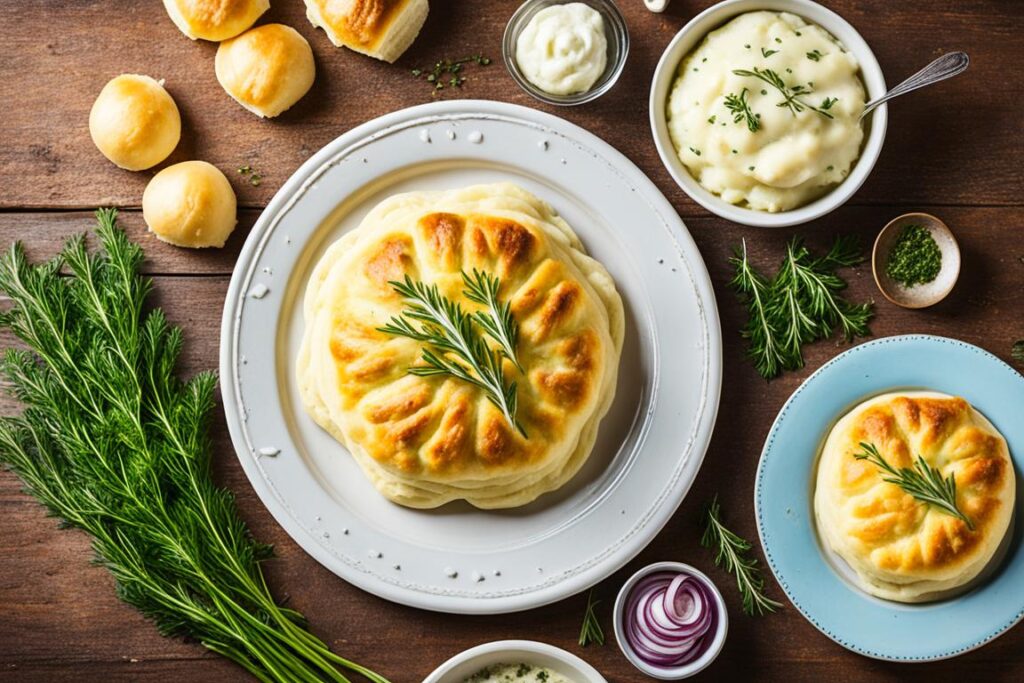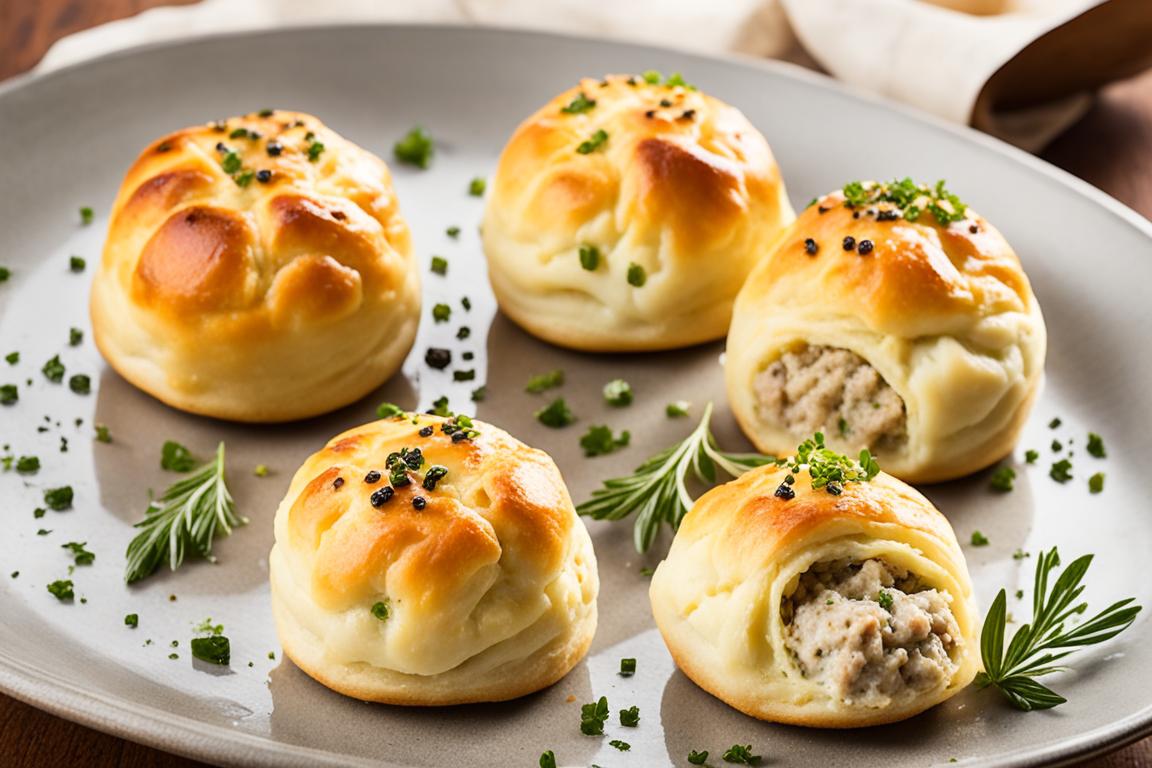Ever wondered why some traditional foods hold deep cultural value while others disappear? The knish is a pastry that connects us to Jewish cuisine’s rich heritage. But what does the word knish mean, and how has it changed over time? To truly understand this tasty treat, we must explore its knish origins and its place in cultural history.
Key Takeaways
- The term “knish” refers to a filled pastry that is either baked or fried.
- Knishes have their knish origins in Eastern European Jewish cuisine.
- The definition of a knish extends beyond its ingredients to embody cultural significance.
- Knishes have recently surged in popularity within North American urban areas.
- This pastry reflects a blend of nostalgia and evolving tastes in modern culinary arts.
Knish Definition
The knish is a favorite snack in many cultures, especially in Jewish cuisine. It’s a savory treat with a dough wrapper filled with various ingredients. This shows how versatile the knish definition is. To understand knish, we need to look at its ingredients and its role in food traditions.
Understanding the Term
A knish is like a dumpling but often seen as a pastry. It can be a snack or a full meal. You can fill it with mashed potatoes, ground meats, cheeses, or vegetables. This variety shows the wide range of flavors and textures knishes offer.
Common Uses in Cuisine
Knishes are found in delis, bakeries, and food stalls across the U.S. They are often eaten hot and are a comfort food for many. Traditional recipes blend with new ideas, making knishes perfect for today’s food scene. They are adaptable, fitting into many tastes and preferences.
| Fillings | Preparation Style | Common Locations |
|---|---|---|
| Mashed Potatoes | Baked or Fried | Jewish Delis |
| Ground Meat | Baked | Bakeries |
| Cheese | Fried | Food Trucks |
| Vegetables | Stuffed and Baked | Street Vendors |
What does the word knish mean in English?
The word “knish” is very important in Jewish and Eastern European cultures. It’s key to understand its linguistic roots to see how it has grown in modern food scenes.
The Linguistic Roots
The knish meaning comes from the Yiddish word קניש (k’nish). It’s connected to Ukrainian “knysh” and Polish “knysz.” This shows the dish’s deep roots in Eastern Europe. It highlights the blend of culture and food history.
Modern Interpretations
Today, knish has taken on new meanings. While old knishes were filled with potatoes or meats, now there are many new ingredients. These changes make knish more appealing to everyone, including those on special diets. This keeps the traditional knish spirit alive for more people.

| Aspect | Traditional Knish | Modern Knish |
|---|---|---|
| Typical Fillings | Potato, Meat | Vegan, Gluten-Free |
| Cultural Origin | Eastern European | Global Adaptations |
| Popularity | Jewish Delis | Widespread Gourmet Interest |
| Presentation | Simple, Homey | Artistic, High-End |
For more info on the knish meaning, check out dictionaries and food articles. They offer a deeper look into this interesting topic.
Knish Origins
The knish is a key part of Jewish food traditions. It comes from the cultural background of Ashkenazi communities in Central and Eastern Europe. Its origins tell us a lot about the lives and customs of these communities over time.
Cultural Background
Knishes were a big deal in Jewish communities, especially in Poland and Ukraine. They were a main food. This shows a time of being careful with food and using what was available, like potatoes and flour.
People made these pastries to make meals that were both filling and tasty. They used leftovers or seasonal veggies to make them.
Historical Development in Europe
The knish has its roots in medieval Europe. It started as a fried vegetable patty and then turned into the stuffed pastry we know today. When Jewish people moved to new places, they took the knish with them.
This pastry became a symbol of home and tradition in new lands. The story of the knish shows how food can change and move with people, sharing cultures along the way.
Knish Ingredients
Knishes are a delightful snack that rely on a few key ingredients. The dough is made from flour and water. It’s simple but perfect for holding different fillings.
Main Components
The dough wraps around the fillings in a knish. These fillings bring a mix of flavors and textures. Traditional fillings include:
- Mashed potatoes
- Onions
- Ground meats
- Cheese
- Kasha (buckwheat)
Now, knishes also come with new ingredients. Sweet potatoes, vegetables like spinach or mushrooms, and quinoa are popular choices. These options show how the dish has evolved.
Popular Fillings
Knishes offer a wide range of fillings for different tastes. You can find everything from savory to sweet. Some well-known fillings are:
| Filling Type | Description |
|---|---|
| Potato | A classic choice, creamy mashed potatoes paired with spices. |
| Kasha | Buckwheat adds a nutty flavor and hearty texture. |
| Meat | Ground beef or chicken offers a protein-rich option. |
| Vegetarian | Spinach and cheese create a flavorful vegetarian option. |
| Sweet Potato | Brings a hint of sweetness and unique texture. |
This variety makes knishes more exciting and shows the creativity in Jewish cuisine. Using different knish ingredients means there’s something for everyone.

Knish Varieties
Knishes come in many flavors, each with its own special taste. They are known for their fillings and shapes. These varieties can please many different tastes. Learning about the types of knishes and regional differences can make you appreciate them more.
Types of Knishes
Several types of knishes are popular:
- Potato Knishes: These are loved for their mashed potato filling.
- Meat Knishes: These have a filling of ground meat for those who like hearty flavors.
- Sweet Knishes: These are filled with fruits or chocolate, perfect for dessert lovers.
- Vegetable Knishes: These are great for vegetarians, filled with different vegetables.
Regional Differences
Knishes vary by region, affecting their taste and how they’re made. In New York City, knishes are often big and filled with meat and potatoes. In Israel, they might use different spices and herbs. This shows how culture affects the taste of knishes around the world.
| Type of Knish | Main Ingredients | Popularity Region |
|---|---|---|
| Potato Knish | Mashed potatoes, onion | New York |
| Meat Knish | Ground beef or chicken | Eastern Europe, NY |
| Sweet Knish | Fruit or chocolate filling | General |
| Vegetable Knish | Mixed vegetables | Israel |
Exploring knish varieties shows their rich flavors and cultural ties. For those looking to try new foods, learning about these knish types can make meals more interesting. Those interested in food differences might also enjoy learning about tortellini and tortelloni.
Knish Pronunciation
Learning the right way to say knish is key for those who love this tasty treat. It’s often said as /kəˈnɪʃ/ or /knɪʃ/, with a big stress on the second syllable. This way, people can connect with the dish’s cultural roots.
How to Pronounce Knish
Knowing how to say knish right is useful, especially when talking about food. Breaking down the syllables helps get it right. Start with a ‘k’ sound like in “kite,” then a schwa sound (/ə/), and end with ‘nish’ which is similar to “nish” in “finish.”
Listening to native speakers can make it easier to learn the right sounds. For clear instructions, check out online guides, like verified pronunciation guides.
Common Mispronunciations
Even though knish is loved in food circles, it’s often mispronounced. This happens because many don’t know Yiddish well. Some might stress the wrong syllable or change the vowel sounds. These mistakes can confuse people and lessen their love for the dish.
Teaching the correct way to say knish can help people respect its cultural background more.
Knish Recipes
Knish recipes blend tradition and innovation for a delightful culinary adventure. They offer a taste of heritage with classic fillings. At the same time, they bring in new tastes for today’s diverse diets.
Traditional Knish Recipes
Traditional knish recipes focus on a simple dough filled with classic ingredients. You’ll find fillings like:
- Potato
- Kasha
- Cheese
- Meat
These recipes highlight quality and flavor, connecting us to our culinary past. Each knish is made by hand, giving it a homemade feel that touches the heart.
Modern Variations
With changing tastes, knish recipes have evolved. Now, they include:
- Vegan fillings, such as mushrooms and lentils
- Gluten-free dough options
- Unique spices and herbs
- Creative combinations like spinach and feta
This flexibility makes knishes appealing to today’s food lovers. They mix tradition with modern tastes, offering something for everyone.
| Ingredient Type | Traditional Fillings | Modern Fillings |
|---|---|---|
| Starch | Potato | Cauliflower |
| Cereal | Kasha | Quinoa |
| Dairy | Cottage Cheese | Almond Cream |
| Meat | Beef | Jackfruit |
Knish History
The knish first came to the United States with Ashkenazi Jewish immigrants in the early 1900s. These immigrants settled in cities, especially New York City. There, the knish became a key part of American Jewish food culture.
This dish from Eastern Europe turned into a favorite in American Jewish homes. It shows how a community keeps its food traditions alive and changes them to fit new places.
Arrival in the United States
The knish’s arrival in the U.S. was a big deal. It quickly became a hit as a street food and was sold in bakeries and delis. People loved its tasty fillings, like potatoes and meat.
Soon, the knish became a symbol of the immigrant experience. It brought people together through food, showing how different backgrounds can share a love for good food.
Impact on American Cuisine
The knish has made a big mark on American food. It moved from being a Jewish dish to a favorite everywhere. Now, you can find knishes with many fillings, attracting more people.
This pastry represents Jewish heritage and shows how traditional foods can evolve. For those curious about Jewish food, resources like this guide can deepen their understanding and enjoyment of these dishes.


